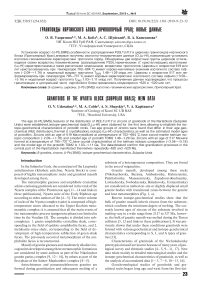Granitoids of the Nyarta block (Subpolar Urals): new data
Автор: Udoratina O.V., Coble M.A., Shuyskiy A.S., Kapitanova V.A.
Журнал: Вестник геонаук @vestnik-geo
Рубрика: Научные статьи
Статья в выпуске: 9 (297), 2019 года.
Бесплатный доступ
The age (U-Pb, SIMS), features of the distribution of REE, Ti, Hf, Y in zircons of granitoids of the Nikolayshorsky massif (Subpolar Urals) were determined and isotope-geochemical data (O, Lu-Hf) were obtained. These data allowed establishing the age and characteristics of protolith. The data confirmed the formation of granites in the range of 640-520 Ma. Evidence of different age stages was found in one sample of zircons from the Nikolayshorsky massif. The determined temperature ranges for the formation of zircons indicated that their crystallization (620 Ma) had occurred at a temperature lower than zircons with ages 520 Ma. The isotopic composition of zircon oxygen indicated a crustal source, the hafnium isotopic composition indicated a crust-mantle one, the model ages of protoliths were 1.48-1.02 and 1.11 Ga for zircons of different ages. Granites with the petro-geochemical characteristics of S-granites were formed during granitogenesis processes appeared at different times - 620 and 520 Ma ago.
S-граниты, u-pb (sims), s-granites, zircons, isotope-geochemical characteristics, subpolar urals
Короткий адрес: https://sciup.org/149129399
IDR: 149129399 | УДК: 550.93 | DOI: 10.19110/2221-1381-2019-9-23-32
Текст научной статьи Granitoids of the Nyarta block (Subpolar Urals): new data
In the Subpolar Urals, the central part of the Lyapinsky anticlinorium (Khobeiz anticline, Nyarta block) is composed of highly metamophysic rocks and granitoid massifs developed among them.
The metamorphic gneisses and amphibole crystalline schists enclosing granitoids are considered in the rank of the Nyarta complex of the Proterozoic age [11—14 and links in these publications], Nyarta suite of the Early Riphean age according to other authors of the [4—5]. The entire volume of rocks of the Nyarta complex (suite) is composed of high-temperature zones allocated to the Upper Kozhim metamorphic complex; it is assumed that all the main events of the metamorphic process (progressive phase) are limited in time by the Vendian [5]. The complex is divided into subcomplexes: 1. gneiss-amphibolite-crystalline shale, corresponding to the field of epidote-amphibolite facies, and 2. metabasite-mica-shale, corresponding to the field of development of high-temperature subfaction of green-shale facies. The previously occurred metamorphism of the amphibolite facies is reconstructed.
Massifs of granite gneisses and moderately alkaline leu-cogranites developed among these metamorphic formations are considered by some authors as part of the Nikolayshor granite gneiss complex [9, 12—14], by others as part of the first phase of the Salner-Manhambov complex [4—5].
Autochtonous and paraautochthonous granites are formed during granitization and subsequent melting of a substrate of a heterogeneous composition. They are found in the area of migmatites.
Granite massifs, developed among these rocks (Nikolayshorsky, Bazisny, Ambashorsky, Halmeryusky, Palnikshorsky, Mansaranizsky, Zapadnosvobodnensky, Lavkashorsky, Svobodnensky, Balashovsky, Ustnyartinsky) are considered as melted on-site or slightly displaced small granite bodies with transitional zones between the granite and host metamorphites (Fig. 1, a).
Recent isotope-geochemical studies show that the bulk of granite massifs inherit zircons from the substrate, which confirms the minimum degree of melting. The currently known ages of zircons of the substrate involved in melting vary in a wide range from 2127 to 327 Ma, however, the bulk of granite massifs was melted during the Timan collision [3, 12 and links in these publications]. It was previously shown that under these conditions granitoids were formed with various geochemical and isotope-geochemical characteristics corresponding to S, I, and A types of granites [15].
Characteristics of granitoids of the Nicholashorsky petrotypical massif are known because of many years of geological survey and thematic studies [4—5, 9—11, 17]. New data relate mainly to detailed mineralogical studies and the isotope-geochemical characteristics of granitoids, as well as the analysis of accumulated data [1—3, 7—8, 10—13, 16].
Geochronological studies of granitoids and gra-nitized rocks began long ago and went from the first dat- 23
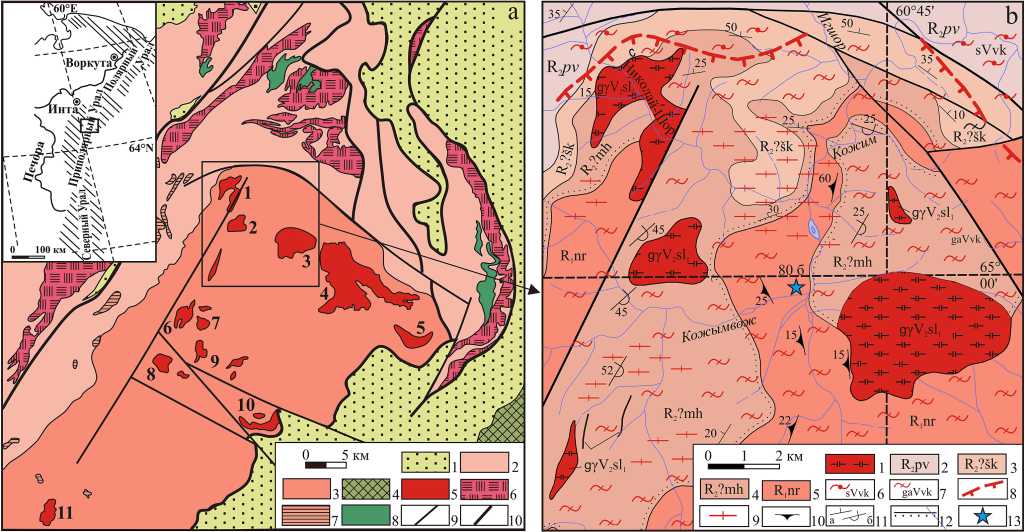
Рис. 1. а) Схема размещения гранитоидных массивов ядра Хобеизской антиклинали. 1 — образования Западно-Уральской метазоны; 2—3 — образования Центрально-Уральской мегазоны: 2 — среднего рифея-венда, 3 — нижнего-среднего рифея (ядро Хобеизской антиклинали); 4 — комплексы Тагильской мегазоны; 5 — гранитоидные массивы ядра Хобеизской антиклинали; 6—8 — интрузивные комплексы позднего рифея-кембрия в обрамлении ядра Хобеизской антиклинали: 6 — сальнерско-маньхамбовский, 7 — панэчаизский, 8 — парнукский; 9 — разломы; 10 — надвиги. Цифрами на схеме обозначены массивы: 1 — Николайшорский, 2 — Базисный, 3 — Амбаршорский, 4 — Хальмеръюский, 5 — Пальникшорский, 6 — Маньсаранизский, 7 — Западносвободненский, 8 — Лавкашорский, 9 — Свободненский (выделен пунктирной рамкой), 10 — Балашовский, 11 — Устьняртинский. b) Геологическая карта северного обрамления няртинского гнейсо-мигматитового комплекса (по [5]).
b) 1 — сальнерско-маньхамбовский комплекс гранит-лейкогранитовый ( Y —l y V2—C1sl) (гнейсо-граниты); 2 — пуйвинская свита (R2pv); 3 — щокурьинская свита (R2?sk); 4 — маньхобеинская свита (R2?mh); 5 — няртинская свита (R 1 nr); верхнекожимский метаморфический комплекс (Vvk): фации регионального метаморфизма: 6 — зеленосланцевая (метабазит-слюдяносланцевый «подкомплекс» sVvk), 7 — эпидот-амфиболитовая (гнейсо-амфиболит-кристаллосланцевый «подкомплекс» gaVvk); 8 — граница метаморфических фаций и субфаций; 9 — гранитизированные породы; 10 — элементы залегания метаморфической и кристаллизационной сланцеватости; 11 — элементы залегания слоистости: а — наклоного, б — опрокинутого; 12 — несогласное залегание; 13 — точка отбора (обр. 80б)
Рис. 1. а) Layout of granitoid massifs of the core of the Khobeiz anticline. 1 — formations of the West Ural megazones; 2—3 — formations of the Central Ural megazone: 2 — Middle Riphean-Wenda, 3 — Lower-Middle Riphean (core of the Khobeiz anticline); 4 — Tagil megazone complexes; 5 — granitoid massifs of the core of the Khobeiz anticline; 6—8 — intrusive complexes of the Late Riphean-Cambrian framed by the core of the Khobeiz anticline: 6 — Salnier-Manhambov, 7 — Panechaiz, 8 — Parnuk; 9 — faults; 10 — thrusts. The numbers on the diagram indicate the arrays: 1 — Nikolayshorsky, 2 — Basisny, 3 — Ambarshorsky, 4 — Halmeryusky, 5 — Palnikshorsky, 6 — Mansaranizsky, 7 — Zapadnosvobodnensky, 8 — Lavkashorsky, 9 — Svobodnensky (highlighted with a dashed frame), 10 — Balashov, 11 — Ustnartinsky. b) Geological map of the northern frame of the Nyarta gneiss-migmatite complex (according to [5]).
b) 1 — Salnier-Manhambov granite-leucogranite complex ( Y —l y V2—C1sl) (gneiss granites); 2 — Puyvinskaya Suite (R2pv); 3 — Shchokurinskaya Suite (R2?sk); 4 — manhobeinskaya suite (R2?mh); 5 — Nyarta Suite (R 1 nr); Upper Kozhimsky metamorphic complex (Vvk): facies of regional metamorphism: 6 — green shale (metabasite-mica shale “subcomplex” sVvk), 7 — epidote-amphibolite (gneiss-amphibolite-crystal-shale “subcomplex” gaVvk); 8 — border of metamorphic facies and subfacies; 9 — granitized rocks; 10 — elements of occurrence of metamorphic and crystallization schists; 11 — elements ofbedding: a — inclined, b — overturned; 12 — dissonant bedding; 13 — sampling point (sample 80b)
ing of K-Ar, Rb-Sr, Pb-Pb methods, highlighted the main stages of granite formation in this region based on them for a long time [2]. Based on the ages established in recent years for some U-Pb zircon massifs (SIMS): (Halmeryusky (638 ± 6, n = 10), Ambashorsky (520 ± 7, n = 9), Lavkashorsky (327±3, n = 2; 489±6, n = 1; 560 ± 4, n = 3; 1756 ± 19, n = 1;), Svobodnensky (476 ± 11, n = 5; 553 ± 8, n = 3), it is shown that granite formation processes in the core of the Khobeiz anticline (in the rocks of the Nyarta complex (suite)) occurred repeatedly. Some of the zircons, as we believe, are inherited, some reflect the time of formation of the melt, and some subsequent processes, often of all ages (inherited, magmatic stage and transformation stage) can be seen in one zircon crystal [3—5].
The age of granitoids of the petrotypical Nikolayshorsky massif established by the U-Pb (SIMS) method is 640 ± 6.7 [3], 606 ± 3 [14] and correlates geochronologically with the granites of the Salnier-Manhambov complex developed in the frame of the Nyarta block.
The new isotope-geochronological data on granitized rocks, composing the volume of the Nyarta block, allows us to determine the isotope-geochemical features of melting protoliths and the crystallization temperatures and the age of granitization processes more accurately.
Methods
The studies were carried out at the CCU “Geoscience”, IG Komi SC UB RAS (Syktyvkar): petrographic, micro- probe, and chemical (classical method). The content of rare, scattered, and rare-earth elements were measured at the Geochemistry Institute of the Russian Academy of Sciences (Moscow) using neutron activation methods and X-ray radiometric methods. Zircon ages were determined using the U-Pb, SIMS method at Stanford University, USA, the research technique is given in [26]. The oxygen isotope composition in zircons was determined at the GIN SB RAS (Ulan-Ude) according to the technique described in [6]. The hafnium isotopic composition was determined by the authors at the Institute of Geology and Mineral Resources (Tianjin, China) according to the [21].
Results and discussion
In the upper reaches of the Kozhim River, where the most complete section of the rocks of the Nyarta complex (suite) is revealed, samples were taken for research (the left side of the Kozhim-Vozh stream at the confluence with the Kozhim river). Here (65°00’13’’; 60°41’32’’) in the rocky outcrop, alternating thicknesses of crystalline schists with granite rocks are observed — the zone of migmatization of the western contact of the Ambashora massif is exposed (Fig. 1, b, a fragment of the geological map of the last generation is given).
The tested rocks are represented by white-gray colored medium-grained gneiss-shaped albitized granite. Mineralogical composition (vol %): Plagioclase (albite) — 30—40, quartz — 40—50, feldspar (microcline) — 25—30, muscovite (up to 3). Accessory minerals: zircon, garnet, allanite, titanite, secondary — sericite, calcite, ore — pyrite. In thin sections lepidogranoblast microstructures with the rarely development of garnet porphyroblast are observed.
According to the Petrographic Code, rocks are classified as acid plutonic normal alkaline rocks (Fig. 2, a). The silica content (wt %) is 77, alumina 13.2, sodium ox-
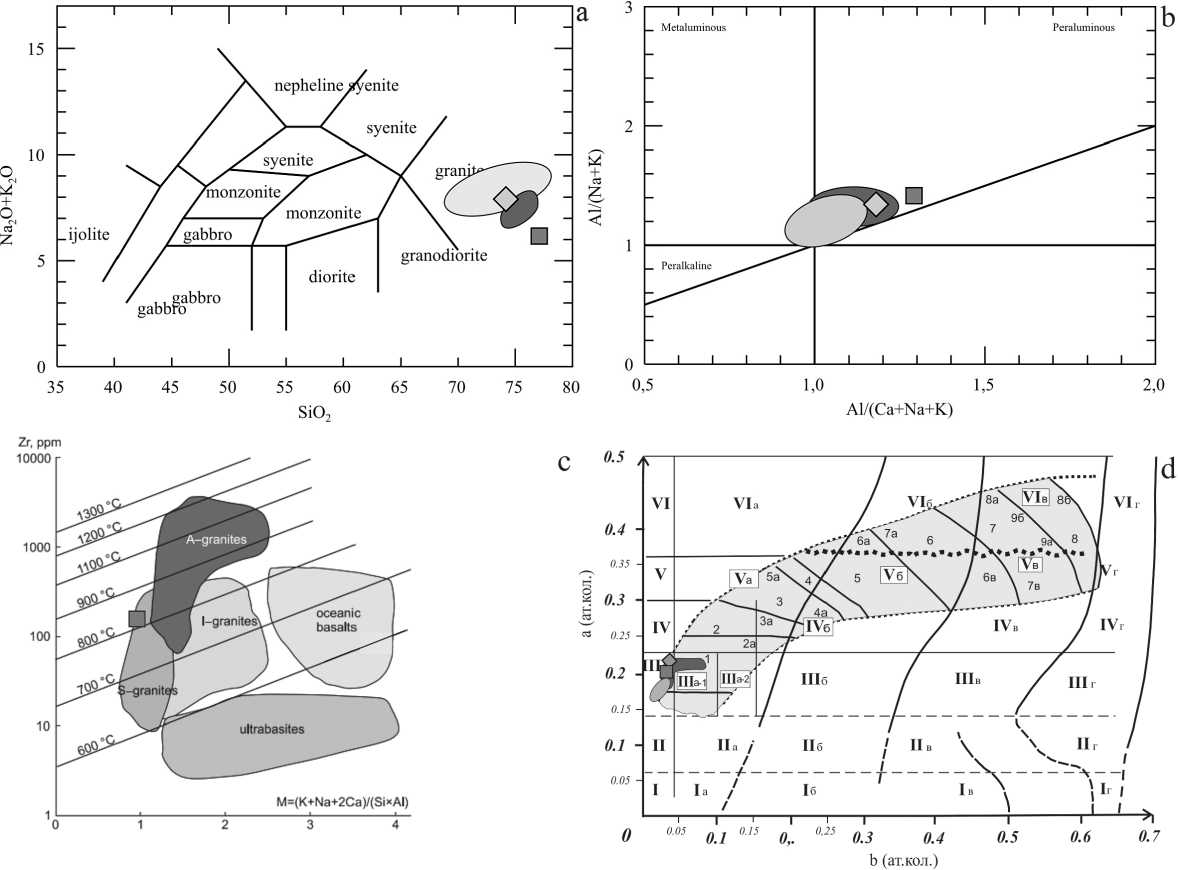
Рис. 2. Диаграммы (Na2O+K2O)—SiO2 (a), Al/(Na+K)/Al(Ca+Na+K) — b, Концентрации насыщения цирконием расплавов разного состава (параметр М) и генезиса при различных температурах по [25], экспериментальные данныe — по [24] — c, диаграмма a-b для реконструкции первичного состава метамагматических пород по А.Н. Неелову — d. Квадрат —положение точки состава пробы 806. Нанесены для сравнении: эллипсы — точки составов пород петротипичного Николайшорского массива взятые из работ [7] (темно серое поле) и неопубликованные данные А.А.Соболевой — серое поле, а также нанесена точка среднего состава гранитоидов Амбашорского массива (ромб) [5]
Fig. 2. Diagrams (Na 2 O + K 2 O) —SiO 2 (a) and Al/(Na+K)/Al(Ca+Na+K) (b), The zirconium saturation concentrations of the melts of different composition (parameter M) and origin at different temperatures (25]). Experimental data after [24] (c), diagram a-b for reconstruction of the primary composition of metamagmatic rocks according to A.N. Neyelov (d) The square is the position of the sample composition point 80b. Ellipses, rock composition points of the Nikolayshorsky massif taken from the works [7] (dark gray field) and unpublished data by A.A.Soboleva — gray field as well as a point of the average composition of granitoids of the Ambashora massif (rhombus) [5]
ide 4.72, potassium oxide 1.44. The rocks are characterized by a significant predominance of Na2O over K2O (Na2O/ K2O — 3.28). The rocks with an agpaity index (0.71), an alumina index ASI (1.29) and an alumina index (al ’— 5.9) are related to those with a high alumina index. The position of the composition point in the diagram Al/(Na+K)– Al/(Ca+Na+K), indicates a significant contribution of crustal (sedimentary) material to the melting substrate (Fig. 2, b), as well as the location of the composition point on the Zr-M diagram (Fig. 2, c). According to the petrogeochemical characteristics of the rocks are S type granites. Our data confirm earlier works, where it was shown that, in their petro-geochemical characteristics, the granites of the central part of the Nyarta block were comparable with S-type granites [3, 10, 15].
On the diagram for reconstructing the paleosubstratum (N. Neelova), the composition point falls into the uncertainty field of arkosis and rhyolite (Fig. 2, d). Based only on chemical composition data, it is impossible to distinguish highly metamorphosed volcanics and terrigenous sediments — arkoses.
The REE in rock content is 324.72 g/t; a slight predominance of light REE over heavy (LaN / YbN — 9.46) and a clearly seen Eu minimum (Eu/Eu* — 0.38) are observed at the REE distribution spectra (Fig. 3, a). On the multielement diagrams the large cationic elements predominate over highly charged elements (Fig. 3, b). For comparison, the profiles of the spectra of granitoids of the Nikolayshorsk petrotypical massif are plotted on the charts; unfortunately, there are no data for the rocks of the Ambarshor massif. As can be seen in the studied rocks there are no negative anomalies (Ta, Nb, P, Eu) characteristic of the rocks of the petrotypical massif.
Zircons selected for research (sample 80b) are represented by small light yellow transparent grains saturated with inclusions. There are (1) wide-prismatic (tabular) with a well-developed prism and undeveloped pyramids crystals (150—100 µm, Ku 1:2), as well as (2) long-prismatic crystals with well-defined heads (100 µm, Ku 1:3).
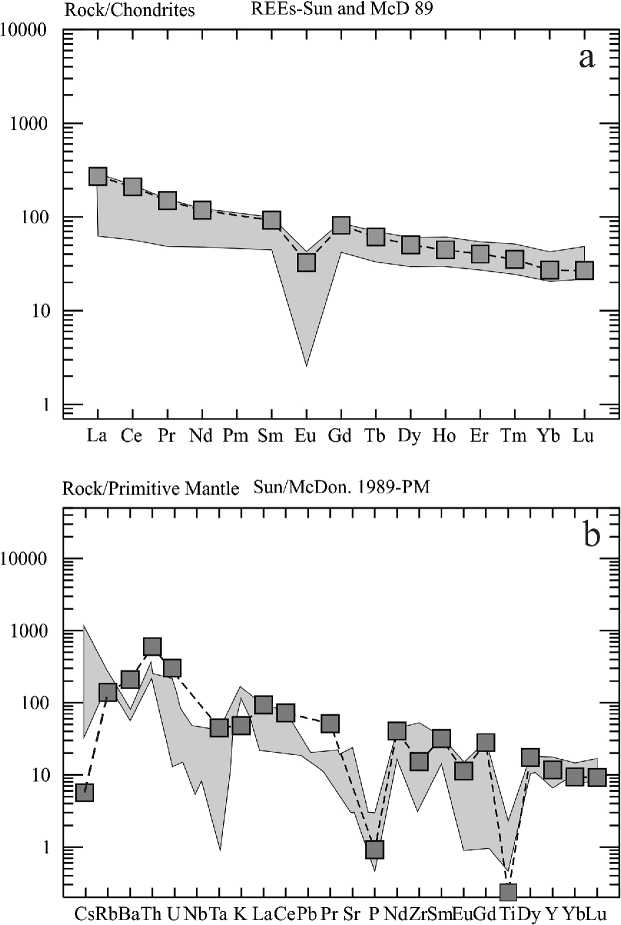
Рис. 3. Распредеёе^ие РЗЭ (а) и мyёьтиэёeмeнт^aя диа-ãðàììà (b) â ïîðîäàõ. Ñåðîå ïîëå íåîïóáëèêîâàííûå äàí-íûå À. À. Ñîáîëåâîé
Fig. 3. Distribution of REE (a) and Multi-element diagram (b) in the rocks. Gray field unpublished data by A. A. Soboleva
Таблица 1. Химический состав (мас.%), содержание элементов примесей (г/т) è èíäèêàòîðíûå îòíîøåíèÿ â ïîðîäå
Table 1. Chemical composition (wt. %), content of elements (ppm) and characteristic rations of the rock Õèìè÷åñêèé ñîñòàâ /Chemical composition
|
80á |
SiO 2 |
TiO 2 |
Al 2 O 3 |
Fe 2 O 3 |
FeO |
MnO |
MgO |
CaO |
Na2O |
K 2 O |
P 2 O 5 |
ÏÏÏ |
|
77.11 |
0.001 |
13.17 |
1.07 |
1.07 |
0.03 |
0.2 |
0.5 |
4.72 |
1.44 |
0.02 |
0.21 |
Èíäèêàòîðíûå îòíîøåíèÿ / Indicative ratios
|
80á |
ASI |
Ga/Al |
K/Rb |
à.è. |
Êô |
al` |
Fe* |
Na2O + K2O |
Na2O/K2O |
(La/Yb)n |
Eu/Eu* |
S |
|
1.29 |
1.86 |
135.2 |
0.7 |
0.91 |
5.9 |
0.8 |
6.2 |
3.28 |
9.5 |
0.4 |
324.7 |
Ýëåìåíòû /Elements
|
Sr |
Rb |
Ba |
Ta |
Hf |
Ga |
Zr* |
Nb* |
Y* |
La |
Ce |
Pr |
|
|
- |
88.4 |
1165 |
1.83 |
9.72 |
13 |
230 |
90 |
100 |
64.4 |
128 |
14.2 |
|
|
80á |
Nd |
Sm |
Eu |
Gd |
Tb |
Dy |
Ho |
Er |
Tm |
Yb |
Lu |
Cs |
|
55 |
14.1 |
1.9 |
16.7 |
2.28 |
12.8 |
2.52 |
6.65 |
0.9 |
4.59 |
0.68 |
0.044 |
|
|
Sc |
Cr |
Co |
Ni |
Zn |
Se |
As |
Sb |
Th |
U |
Br |
Au |
|
|
4.61 |
21.2 |
1.06 |
- |
270 |
5.65 |
26.4 |
1.25 |
20.8 |
6.65 |
0.62 |
- |
Ïðèìå÷àíèå: * — ýëåìåíòû îïðåäåëåíû ðåíòãåíî-ðàäèîìåòðè÷åñêèì ìåòîäîì, îñòàëüíûå ìåòîäîì íåéòðîííîé àê-òèâàöèè. «—» íèæå ïðåäåëà îáíàðóæåíèÿ, Fe* — æåëåçèñòîñòü (FeOtot/(FeOtot+MgO)), à. è. — àãïàèòîâûé èíäåêñ (Na + K/Al), ASI — [Al/Ca – 1.67P + Na + K], Êô = (FeO + Fe2O3)/(MgO + FeO + Fe2O3), al` = Al2O3/(Fe2O3+ FeO + MgO).
Note: * — the elements are determined by the X-ray radiometric method, the rest by neutron activation. «—» below detection limit, Fe* — iron index (FeOtot/(FeOtot+ MgO)), à.i — agpaitindex (Na+K/Al), ASI– [Al/Ca – 1.67P + Na + K], Êô = (FeO + Fe2O3)/(MgO + FeO + Fe2O3), al` = Al2O3/(Fe2O3+ FeO + MgO).
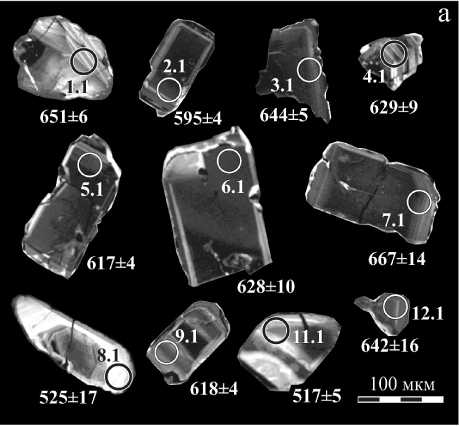
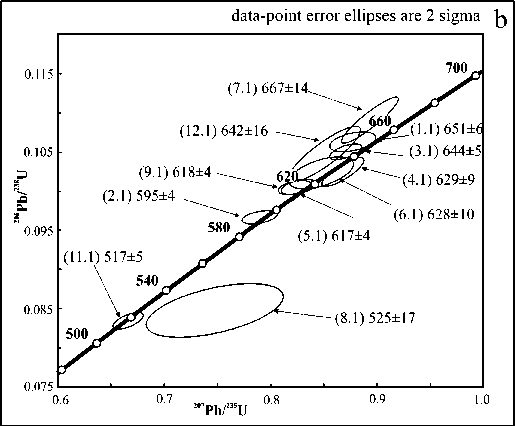
Ðèñ. 4. a — êàòîäîëþìèíåñöåíòíûå èçîáðàæåíèÿ öèðêîíîâ èç ãðàíèòîâ (ïðîáà 80Â) ñ íîìåðàìè äàòèðîâàííûõ çåðåí, àíàëè-òè÷åñêèìè êðàòåðàìè, âîçðàñòîì, b — êîíêîðäèÿ, êîíêîðäàíòíûé âîçðàñò 619 ±5.4, ÑÊÂÎ 1.4, n = 5
Fig. 4. Cathodoluminescence image of zircon from granites (80B) numbers dating grains and analysis of craters (a); Diagram for zircon 80B — (b). The coordinates of points — the center of the ellipse of error (2 σ ). Concordant age for coherent groups of 5 definitions — 619 ± 5.4 million years (2 σ , MSWD = 1.4)
In reflected light, the crystal surface is smooth. In the cathodoluminescent images of the group (1) a wide black central zone (often fractured) and a narrow border with growth zonality (Fig. 4, a) is seen; crystals of the second group are characterized by lighter, gray tones of the central parts and white edge zones. The surface of the crystals is smooth in reflected light. According to their morphology, zircons belong to the 4th type identified by Yu. I. Pystina [12], typical of the amphibolite facies (for migmatites), their formation is associated with the presence of a silicate melt, i. e. in fact, they are magmatic zircons [12].
U-Pb zircon age at 11 points was determined (Table 2). We divided zircons in two age groups, the points 1.1, 2.1, 3.1, 7.1 were removed from the calculation. The age range was 1) 642—617 (4.1, 5.1, 6.1, 9.1, 12.1, concordant 619 ± 5.4 Ma, MSWD = 1.4); 2) 525—517 (11.1, 8.1 — 517.6 ± 10.2 Ma, MSWD = 0.05) Ma (Fig. 4, b).
The data, obtained for the first group of zircons, are close to the age of the petrotypical Nikolayshorsk massif (640 ± 6.7, 606 ± 3 Ma), and the age of zircons of the second group is close to the age of granites of the Ambashor massif (520 ± 7 Ma) in the frame of which a sample was taken.
The contents (g/t) of U vary from 210 to 320, Th from 100 to 190 in the first group and from 35 to 235 and 25 to 160, respectively, in the second. The contents of impurity elements in zircons of different age groups differ, which confirms that zircons belong to different generations (Table 3, Fig. 5 a). On the diagrams U/Yb — Y and U/ Yb-Hf zircons, points fall into the field of derivatives of the continental crust (Fig. 5 b-c).
The model crystallization temperature calculated from the titanium content [24] is in the range of 702— 684 °C for the first group and in the range of 795—737 °C

Ðèñ. 5. A-ñïåêòðû ðàñïðåäåëåíèÿ ÐÇÝ (íîðìèðîâàííûå íà õîíäðèò) â öèðêîíàõ, æèðíûå ëèíèè — òî÷êè âîçðàñòíûõ çíà÷å-íèé (525—517 ìëí ëåò). (b—c) äèàãðàììû Y — U/Yb è Hf — U/Yb äëÿ öèðêîíîâ ïîëÿ ïî [23]. Íåçàêðàøåííûé øàð — çíà÷å-íèÿ äëÿ òî÷åê 4.1, 5.1, 6.1, 9.1 (619 ± 5.4), çàêðàøåííûé øàð — òî÷êè 8.1, 11.1 (517.6 ± 10.2), ïîëóçàêðàøåííûé øàð — îñòàëü-íûå çíà÷åíèÿ
Fig. 5. REE distribution spectra (normalized to chondrite) in zircons (a), bold lines — points of age values (525—517 Ma). (b—c)Y — U/ Yb and Hf — U/Yb diagrams for zircon. Fields after [23]. Unfilled ball — values for points 4.1, 5.1, 6.1, 9.1 (6195.4), filled ball — points 8.1, 11.1 (517.610.2), half-filled ball — other values
Таблица 2. Результаты U—Pb изотопных исследований цирконов
Table. 2. Results of U—Pb isotope studies of zircons
|
Зерно. кратер Grain |
206Pbc c , % |
Содержания, мкг Contents, mkg |
232Th/ 238 U |
Возраст, млн лет, ± Age, Ma, ± |
D. % |
Изотопные отношения, ± Isotope ratios, ± |
Rh o |
|||||
|
206Pb* |
U |
Th |
206 Pb/ 238 U |
207Pb/206Pb |
207Pb/206Pb |
207 Pb/ 235 U |
206 Pb/ 238 U |
|||||
|
11.1 |
0.02 |
17 |
237 |
161 |
0.70 |
517±5 |
523±30 |
+ 1 |
0.0578+1.4 |
0.67±1.7 |
0.084±1.0 |
0.6 |
|
8.1 |
0.03 |
3 |
35 |
23 |
0.66 |
525±17 |
737±128 |
+30 |
0.0639±6.0 |
0.75±6.9 |
0.085±3.4 |
0.5 |
|
2.1 |
0.04 |
18 |
219 |
87 |
0.41 |
595±4 |
573±34 |
-4 |
0.0592±1.6 |
0.79±1.7 |
0.097±0.7 |
0.4 |
|
5.1 |
-0.01 |
28 |
319 |
187 |
0.61 |
617±4 |
578±29 |
-7 |
0.0593±1.3 |
0.82±1.5 |
0.101±0.7 |
0.5 |
|
9.1 |
-0.07 |
19 |
222 |
111 |
0.51 |
618±4 |
588±31 |
-5 |
0.0596±1.4 |
0.83±1.6 |
0.101±0.8 |
0.5 |
|
6.1 |
0.01 |
24 |
269 |
160 |
0.61 |
628±10 |
605±51 |
-4 |
0.0601±2.3 |
0.85±2.9 |
0.102±1.6 |
0.6 |
|
4.1 |
0.08 |
25 |
289 |
168 |
0.60 |
629±9 |
651±23 |
+4 |
0.0614±1.1 |
0.87±1.8 |
0.103±1.5 |
0.8 |
|
12.1 |
-0.17 |
19 |
213 |
98 |
0.48 |
642±16 |
563±34 |
-15 |
0.0589±1.5 |
0.85±3.1 |
0.105±2.7 |
0.9 |
|
3.1 |
-0.16 |
26 |
291 |
187 |
0.66 |
644±5 |
606±24 |
-7 |
0.0601±1.1 |
0.87±1.4 |
0.105±0.8 |
0.6 |
|
1.1 |
-0.25 |
13 |
139 |
48 |
0.36 |
651±6 |
597±40 |
-10 |
0.0599±1.8 |
0.88±2.0 |
0.106±0.9 |
0.4 |
|
7.1 |
-0.30 |
25 |
268 |
178 |
0.69 |
667±14 |
580±23 |
-16 |
0.0594±1.1 |
0.89±2.4 |
0.109±2.2 |
0.9 |
Примечание. 206Pbc и 20б рь* — обыкновенный и радиогенный свинец. Изотопные отношения и содержания 206Pb скорректированы по измеренному 204Pb. D — дискор-дантность: D = 100 х [возраст (207Pb/206Pb) / возраст (206Pb/238U) — 1]. Rh o — коэффициент корреляции между ошибками определения изотопных отношений 206Pb/238U и 207 Pb/ 235 U.
Note. 206Pbc and 206Pb * — ordinary and radiogenic lead. The isotopic ratios and contents of 206Pb are corrected for the measured 204Pb. D — discordance: D = 100 х [age (207Pb / 206Pb) / age (206Pb / 238U) — 1]. Rho is the correlation coefficient between errors in determining the isotopic ratios 206Pb / 238U and 207Pb / 235U.
Таблица 3. Содержания иттрия, редкоземельных элементов, железа и титана (г/т) и температуры кристаллизации (°C) в исследованных цирконах
Table 3. Content of yttrium, rare earth elements, iron and titanium (ppm) and crystallization temperature (°C) in the studied zircons
|
Çåðíî / Grain |
Y |
La |
Ce |
Nd |
Sm |
Eu |
Gd |
Dy |
Er |
Yb |
Hf |
Fe |
48 Ti |
49 Ti |
t° (1.0/0.7) |
|
11.1 |
891 |
0.02 |
25 |
1.7 |
3.4 |
1.4 |
25 |
84 |
147 |
270 |
9338 |
55 |
4.4 |
4.2 |
737 |
|
8.1 |
276 |
0.01 |
13 |
0.2 |
0.5 |
0.26 |
5 |
24 |
48 |
103 |
8896 |
11 |
8.1 |
8 |
795 |
|
2.1 |
1056 |
0.03 |
16 |
0.8 |
2.3 |
0.56 |
26 |
105 |
182 |
344 |
9144 |
33 |
2.5 |
2.4 |
686 |
|
5.1 |
1860 |
0.16 |
28 |
2.1 |
4.8 |
1.12 |
48 |
200 |
330 |
505 |
9055 |
35 |
2.7 |
2.6 |
694 |
|
9.1 |
1436 |
0.02 |
19 |
0.8 |
3.1 |
0.76 |
35 |
143 |
248 |
378 |
9307 |
26 |
2.7 |
2.5 |
691 |
|
6.1 |
2095 |
0.01 |
16 |
2.2 |
6.4 |
1.42 |
61 |
222 |
355 |
551 |
9352 |
34 |
2.2 |
2.1 |
674 |
|
4.1 |
1355 |
1.14 |
23 |
2.4 |
3.7 |
0.88 |
35 |
145 |
243 |
381 |
8912 |
42 |
3 |
2.8 |
702 |
|
12.1 |
1120 |
0.01 |
16 |
0.8 |
2.5 |
0.63 |
27 |
115 |
199 |
326 |
9404 |
28 |
2.4 |
2.4 |
684 |
|
3.1 |
2467 |
0.02 |
17 |
2.3 |
7.1 |
1.59 |
72 |
274 |
431 |
636 |
9617 |
37 |
2.3 |
2.2 |
679 |
|
1.1 |
844 |
0.05 |
10 |
0.4 |
1.4 |
0.37 |
17 |
85 |
155 |
265 |
9577 |
25 |
2.2 |
2.1 |
676 |
|
7.1 |
1723 |
0.02 |
21 |
1.9 |
4.5 |
1.71 |
52 |
200 |
302 |
462 |
8326 |
32 |
3.9 |
4.0 |
726 |
Таблица 4. Изотопный состав Hf в цирконах
Table 4. Hf isotope composition of zircons
|
Çåðíî Grain |
T(ìëí ëåò) T(Ma) |
176 Yb/ 177 Hf |
2o |
176 Hf/ 177 Hf |
2o |
176 Lu/ 177 Hf |
2o |
TDM (ìëðä ëåò) T(Ga) |
f L/Hf) |
eHf(0) |
eHf(t) |
TDM2 (ìëðä ëåò) T(Ga) |
|
1.1 |
653 |
0.018629 |
0.000061 |
0.00075 |
0.000003 |
0.282402 |
0.000018 |
1.193 |
-1 |
-13.081 |
0.91 |
1.35 |
|
2.1 |
596 |
0.029621 |
0.000042 |
0.00123 |
0.000002 |
0.282421 |
0.000018 |
1.182 |
-1 |
-12.425 |
0.15 |
1.34 |
|
3.1 |
645 |
0.051888 |
0.000153 |
0.00193 |
0.000002 |
0.282342 |
0.000018 |
1.317 |
-0.9 |
-15.214 |
-1.90 |
1.49 |
|
4.1 |
629 |
0.043429 |
0.000317 |
0.00167 |
0.000011 |
0.282452 |
0.000019 |
1.152 |
-0.9 |
-11.331 |
1.76 |
1.29 |
|
5.1 |
618 |
0.033111 |
0.000129 |
0.00128 |
0.000005 |
0.282389 |
0.000017 |
1.228 |
-1 |
-13.546 |
-0.52 |
1.40 |
|
6.1 |
629 |
0.042037 |
0.000361 |
0.00160 |
0.000013 |
0.282412 |
0.000018 |
1.206 |
-1 |
-12.744 |
0.38 |
1.36 |
|
7.1 |
669 |
0.043574 |
0.000099 |
0.00166 |
0.000004 |
0.282356 |
0.000020 |
1.287 |
-0.9 |
-14.696 |
-0.77 |
1.45 |
|
9.1 |
618 |
0.028904 |
0.000199 |
0.00112 |
0.000008 |
0.282343 |
0.000019 |
1.288 |
-1 |
-15.178 |
-2.09 |
1.48 |
|
8.1 |
525 |
0.066620 |
0.000284 |
0.00280 |
0.000032 |
0.282620 |
0.000026 |
0.94 |
-0.9 |
-5.3789 |
5.16 |
1.03 |
|
11.1 |
517 |
0.015132 |
0.000081 |
0.00061 |
0.000002 |
0.282559 |
0.000024 |
0.971 |
-1 |
-7.5437 |
3.58 |
1.11 |
Примечание:
eHf(0)= (((176Hf/177Hf ) s /(176Hf/177Hf) cHURo ) -i ) x 1000;
eHf(t) = (((176Hf/177Hf )S - (176Lu/177Hf )S x (e □ t - 1))/ ((176Hf/177Hf)CHUR0 - (176Lu/177Hf )CHUR x (e □ t - 1 ))) - 1 x1000;
T dm = 1/ □ x ln (1 + ((176Hf/177Hf ) s - (176Hf/177Hf) DM /(176Lu/177Hf) s - (176Lu/177Hf) DM );
T DM2 = T Hf1 - (THf1- t ) f C - f s/( C - f DM)); f Lu/Hf = ( 17 6Lu/ 177 Hf)s / ( 176Lu / 177 Hf)cHUR- 1
ãäå (176Lu/177Hf)Sè (176Hf/177Hf)Sèçìåðåííûåçíà÷åíèÿâîáðàçöå (176Lu/177Hf)CHUR= 0.0332 è (176Hf/177Hf)CHUR,0= 0.282772 176Hf/177Hf)DM= 0.28325 [19, 20]); (176Lu/177Hf)DM = 0.0384 и (176Hf/177Hf) DM = 0.28325 [22]), t — возраст кристаллизации циркона и □ = 1.867 x 10-11yr-1[18, 27]. T dm одностадийный возраст модели и TdM2 двухстадийный воз-раст / C , f s , / DMи f L u /нf 3^аче^ия корового источника, образца и деплетированной мантии, соответственно. В наших расчетах f с = -0. 72 (используя среднекоровую величину 176Lu/177Hf = 0.015[18]) и f DM= 0.16 (176Lu/177Hf = 0.0384)[21].
Note: where (176Lu/177Hf)S and (176Hf/177Hf)S are the measured values of samples (176Lu/177Hf)CHUR= 0.0332 and (176Hf/177Hf)CHUR , 0= 0.282772 [19, 20]); (176Lu/177Hf)DM = 0.0384 and (176Hf/177Hf) DM = 0.28325 [22]), t — is the crystallization age of the zircon, and □ = 1.867 x 10-11yr-1 [18, 27]. T dm and T dm 2 are single-stage DM model and two-stage DM2 model ages, respectively. f c, f s, and / D Mare the f Lu/Hf values of the crustal source, the sample and the depleted mantle, respectively. In our calculations, f C= -0. 72 (176Lu/177Hf = 0.015 in average continental crust)[18] and / dm = 0.16 (176Lu/177Hf = 0.0384 [22]).

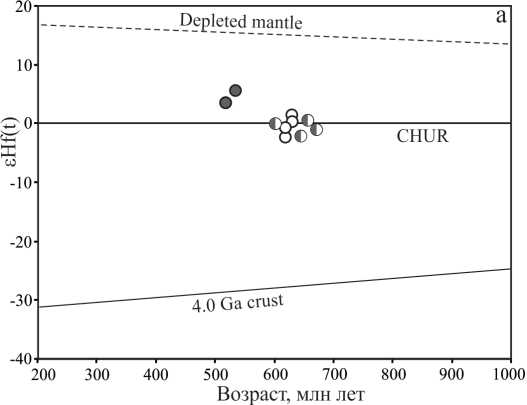
О
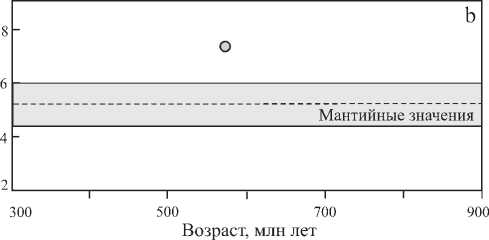
Рис. 6. Изотопный состав Hf (a) и O (b) в продатированных цирконах. Условные обозначения на рис. 5
Fig. 6. The isotopic composition of Hf (a) and O (b) in the zircons dated. Legend in fig. 5
for the second (Table 3). The obtained rather low crystallization temperatures of zircons (characteristic of low-temperature magmatic zircons) are indirectly confirmed by the weak luminescence of the crystals of the first group in cathode rays. The temperature range obtained by saturation of the melt with zirconium shows higher temperatures (Fig. 2, c) of about 800 °C. The calculated temperatures, based on the study of crystal morphology close to our values, were obtained previously for zircons of granitoids of the petrotypical Nikolayshorsk massif 900—800, 700—650, 648—606, showing the complex history of the massif and the presence of zircons fixing various stages [7, 8]. The author of these works also determined low-temperature and higher-temperature zircons and made a conclusion about the repeated granitogenesis of the rocks.
The isotopic composition of hafnium in zircons of the first age group (point 4.1, 5.1, 6.1, 9.1, 12.1) varies from —2.09 to +1.76 and indicates a crust-mantle source, the model age of the protolith TDM 2 is 1.48—1.29 Ga (Table 4, Fig. 6, a). The isotopic composition of hafnium in zircons of the second age group (point 8.1, 11.1) is +3.58 to +5.16, i. e. has mantle characteristics, the estimated model age of the protolith Tdm2 is 1.03—1.11 Ga.
The oxygen isotopic composition ( 8 18O, %% of zircons has positive (+7.31) crust values (Fig. 6, b). High positive values of the oxygen isotopic composition are associated with the research method, since all oxygen of the zircon sample is burned out, and the hafnium isotopic composition was studied locally at the dated zircon points.
Conclusions
The gneiss-shaped granites of the central part of the Nyarta block, developed in the western frame of the Ambashora massif in the zone of development of migmatites, were studied. The rocks belong to S granites and are formed on primary sedimentary rocks, which is indicated by the mineral composition of the rock and petrogeochemical indices. Two age groups of zircons, 619 and 517 Ma, were found in the rocks. Zircons differ in their ages, geochemical (REE distribution), thermal (t° crystallization), isotopic (Hf) characteristics, as well as the estimated model ages of protoliths. The new data show that the granitization processes resulting in the studied rocks occurred in the central part of the Nyarta block in ~620 and ~520 Ma. The obtained time lines in the evolution of this part of the Subpolar Urals correlate with suprasubductionaccretion, collisional, syncollisional, and post-collisional processes (640—520) during which the formation of various types of granitoids, including S-granites, took place [1, 15]. We believe that zircons with an age of 619 ± 5.4 Ma are inherited from the previous melting process. The heating of the strata was stronger in a later period, therefore zircons of the second age group (517.6 ± 10.2 Ma) had higher crystallization temperatures. Either a partial entry of a deeper granite melt into this zone is possible, taking into account more mantle characteristics of these zircons and other model age of the source.
The authors are grateful to F. Mon and C. Gene (China Academy of Sciences, Beijing and the Tianjin Institute of Geology and Mineral Resources, China) for the opportunity to study the Lu-Hf zircon system.
The work is carried out according to No. GR AAAA-A17-117121270035-0, isotope (U-Pb, Lu-Hf) studies were carried out at the expense offinancial resources of the project No. 18-5-5-46 “Evolution of the orogen Protouralid-Timanide according to geological, petrological, geochemical, and isotopic data”.
Список литературы Granitoids of the Nyarta block (Subpolar Urals): new data
- Андреичев В. Л. Геохронология гранитоидного магматизма Приполярного Урала // Вестник Института геологии Коми НЦ УрО РАН. 2010. № 11. С. 7-12.
- Андреичев В. А. Изотопная геохронология доуралид Приполярного Урала. Сыктывкар, 1999. 48 с. (Научные доклады Коми научный центр УрО Российской академии наук; Вып. 413)
- Возраст цирконов из гранитов ядра Хобеизского гранито-гнейсового купола (Полярный Урал) / А. А. Соболева, Н. А. Кузенков, О. В. Удоратина и др. // Происхождение магматических пород: Мат-лы межд. (X Всерос.) петрограф. совещ. Апатиты: Кольский НЦ РАН. 2005. С. 236-238.
- Государственная геологическая карта Российской Федерации. Масштаб 1:1 000 000 (третье поколение). Серия Уральская. Листы Р-40 - Североуральск. Объяснительная записка. СПб.: Картографическая фабрика ВСЕГЕИ, 2005. 332 с.
- Государственная геологическая карта Российской Федерации. Масштаб 1: 200 000. Серия Северо-Уральская. Лист Q-41-XXV. Объяснительная записка / Под ред. М. А. Шишкина. М.: МФ ВСЕГЕИ, 2013. 252 с.

